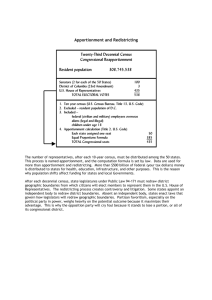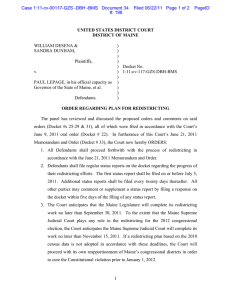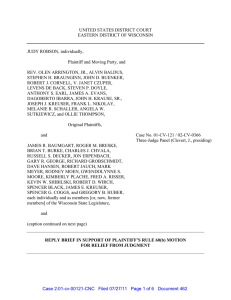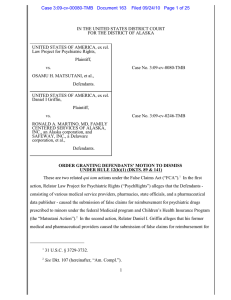ALVIN BALDUS, ET. AL Plaintiffs, TAMMY BALDWIN, GWENDOLYNNE MOORE,
advertisement
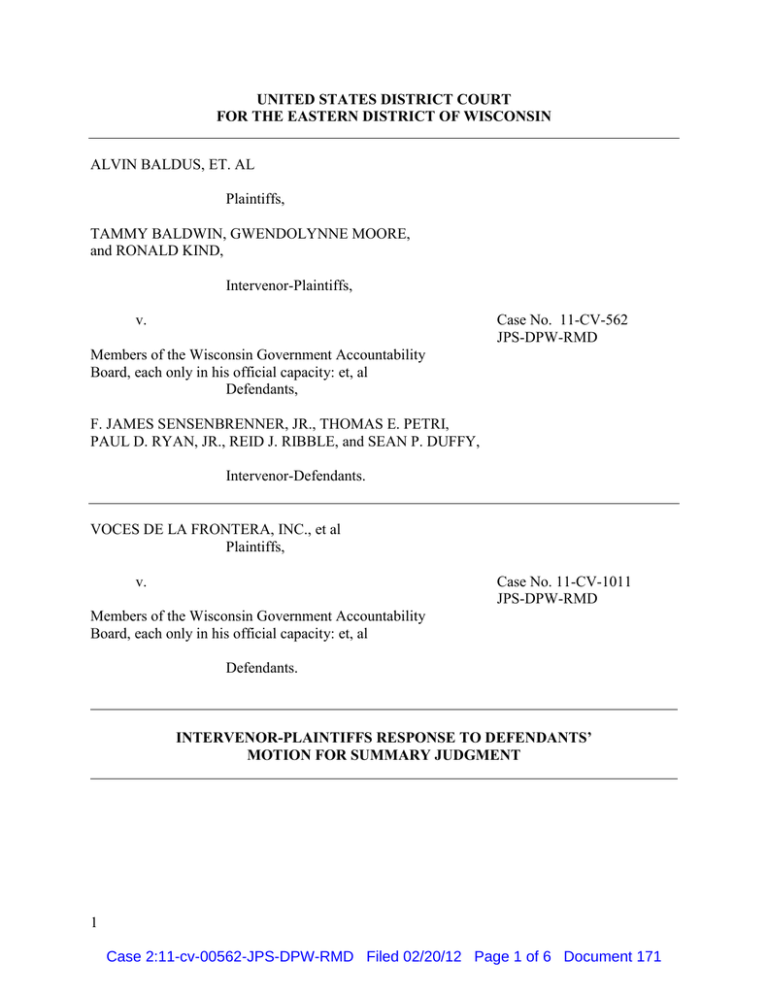
UNITED STATES DISTRICT COURT FOR THE EASTERN DISTRICT OF WISCONSIN ALVIN BALDUS, ET. AL Plaintiffs, TAMMY BALDWIN, GWENDOLYNNE MOORE, and RONALD KIND, Intervenor-Plaintiffs, v. Case No. 11-CV-562 JPS-DPW-RMD Members of the Wisconsin Government Accountability Board, each only in his official capacity: et, al Defendants, F. JAMES SENSENBRENNER, JR., THOMAS E. PETRI, PAUL D. RYAN, JR., REID J. RIBBLE, and SEAN P. DUFFY, Intervenor-Defendants. VOCES DE LA FRONTERA, INC., et al Plaintiffs, v. Case No. 11-CV-1011 JPS-DPW-RMD Members of the Wisconsin Government Accountability Board, each only in his official capacity: et, al Defendants. INTERVENOR-PLAINTIFFS RESPONSE TO DEFENDANTS’ MOTION FOR SUMMARY JUDGMENT 1 Case 2:11-cv-00562-JPS-DPW-RMD Filed 02/20/12 Page 1 of 6 Document 171 I. THE BASIC AIM OF LEGISLATIVE APPORTIONMENT IS TO ACHIEVE FAIR AND EFFECTIVE REPRESENTATION FOR ALL CITIZENS. The Defendants argue that the U.S. Constitution does not mandate core retention, compactness nor communities of interest. (Motion for Summary Judgment Brief, Dkt. 129, p. 3.) The Defendants principally rely upon Gaffney v. Cummings, 412 U.S. 735,752 (note 18). Note 18 states “compactness or attractiveness has never been held to constitute an independent constitutional requirement for legislative districts.” Likewise regarding communities of interest the Defendants cite Graham v. Thornburgh, 207 F. Supp. 2d 1280 (D. Kan. 2002). Graham recognizes that “preserving communities of interest is a legitimate and traditional goal in drawing congressional districts.” Id. at 1297. However, that does not mean that there is an individual constitutional right to have one’s community of interest contained in a legislative district. Id. This was also the result in Gorrell v. O’Malley, 2012 WL 226919 (D.Md. Jan 19, 2012), also cited by Defendants. The Intervenor-Plaintiffs agree with these holdings. None of these acknowledged important redistricting considerations create an independent constitutional requirement. However, that does not end the constitutional inquiry. The basic aim of legislative apportionment is achieving fair and effective representation for all citizens. More fundamentally, Reynolds recognized that “the achieving of fair and effective representation for all citizens is…the basic aim of legislative apportionment,” Gaffney v. Cummings, 412 U.S. 735,748, (1973) (relied on by the Defendants). Fair and effective representation for all citizens is a right derived from the equal protection clause of the 14th Amendment to the Constitution. Any person denied fair and effective representation by a redistricting plan has a constitutional claim based upon equal protection. 2 Case 2:11-cv-00562-JPS-DPW-RMD Filed 02/20/12 Page 2 of 6 Document 171 Furthermore, Gaffney warns: An unrealistic overemphasis on raw population figures, a mere nose count in the districts, may submerge these other considerations and itself furnish a ready tool for ignoring factors that in day-to-day operation are important to an acceptable representation and apportionment arrangement. Id. at 749. The losing argument in the above cases was that the parties attacking the redistricting plan based the attack on a single redistricting principle. Since there are several redistricting principles no single one could be elevated to a constitutional requirement because no one principle necessarily determines fair and effective representation. Furthermore, in none of the cases did the losing party attempt to show how violation of a particular principle impacted dayto-day operation of acceptable representation. The case before this court is different. The Intervenor-Plaintiffs will present evidence that the principles of core retention, compactness, and communities of interest have all been ignored. Furthermore, the Intervenor-Plaintiffs will present evidence, through former Congressman David R. Obey, who represented the Seventh Congressional District for 41 years, that by ignoring these principles the day-to-day operation of fair and effective representation has been damaged by Act 44. (See affidavit of Congressman David R. Obey offered in response to Defendants pending Motion to Dismiss, Dkt. 100.) II. RELYING SOLELY ON ZERO DEVIATION WILL NOT ACHIEVE FAIR AND EFFECTIVE REPRESENTATION. The defendants solely rely on the principle of zero deviation.. Q In terms of being legal, what were the legal 23 requirements, as you understood them, that guided 24 what you did? 25 A The -- I'm sorry. I keep interrupting you. One 3 Case 2:11-cv-00562-JPS-DPW-RMD Filed 02/20/12 Page 3 of 6 Document 171 00051 1 people, one vote; zero deviation. (Andrew Speth Dep. 1/17/2012, Dkt. 143, 50:22 to 51:1.) According to Kevin Kennedy, the Director of the Defendant Government, there are obvious limitations on census data. 3 4 5 6 7 8 9 10 11 12 13 14 15 16 17 18 19 20 21 22 23 24 25 1 2 3 4 5 6 7 8 9 10 11 12 Q And directing your attention to, I believe, paragraph 8, is it your opinion that historically the census data used by the state legislature or federal three-court panels to draw redistricting maps has been inaccurate and incomplete? A Yes. Q And it is -- Your opinion is based on the following reasons, and I think this refers to paragraphs 9, 10 and 11. A, "the census itself (that is, the counting of people by the Census Bureau) is never entirely accurate. The Census Bureau misses some people during its count." Do you agree with that? A Yes. Q B, "the boundary lines and the geographical maps used by the census are not always accurate. The Census Bureau openly acknowledges this." Do you agree with that? A Yes. Q Paragraph C, "the census is outdated as soon as it is released to the public. In the intervening period between when the census is released and the redistricting maps are drawn by either the state 131 legislature or federal three-judge panel, as in 1982, 1992 and 2002 (which can be almost two years in some cases), some people have moved, other people have died, babies have been born, nonvoting age citizens have become of voting age, and some boundary lines have shifted through annexations." Do you agree with that? MR. HODAN: Counsel, you mean paragraph 11 rather than C? MR. HASSETT: Paragraph 11, yes. I'm sorry. MR. HODAN: You can go ahead and 4 Case 2:11-cv-00562-JPS-DPW-RMD Filed 02/20/12 Page 4 of 6 Document 171 13 answer. 14 A Yes. (Kevin Kennedy Dep., 2/8/2012, Dkt. 144, 131:3 to 132:14.) Nonetheless, census data is the best data available for determining ideal population. However, if zero deviation was the only goal of redistricting there could be numerous different boundaries drawn all showing equal population. This means that zero deviation cannot be the sole factor used to determine fair and effective representation. In fact, the concepts of core retention, compactness, and communities of interest are probably equal or more important in achieving fair and effective representation. Furthermore, in this case ideal population could probably have been achieved as well the other redistricting principles. It could be that a valid legislative redistricting plan could be drawn where compactness was sacrificed for some other principle or where other principles were sacrificed to achieve fair and effective representation. However, that was not done in the rush to have this plan adopted. Rather, it was drawn so that a freshman congressman could have more favorable voters in his district. Q All right. Did you remove Portage County 22 from the Seventh Congressional District at 23 Congressman Duffy's request? 24 A Yes. 25 Q Okay. And that was because Congressman Duffy 0151 1 wanted to make the Seventh a more Republican 2 district? 3 A Correct. (Andrew Speth Dep. 1/17/2012, Dkt. 143, 150:21 to 151:3.) Although this amounts to political gerrymandering, the Intervenor-Plaintiffs do not rely on political gerrymandering as a basis for rejection of Act 44. Rather, Act 44 is unconstitutional 5 Case 2:11-cv-00562-JPS-DPW-RMD Filed 02/20/12 Page 5 of 6 Document 171 under the equal protections clause since it deprives voters of the Third, Seventh, and Eighth districts of fair and effective representation. CONCLUSION The Intervenor –Plaintiffs request an opportunity to show that Act 44 does not achieve fair and effective representation. Dated this 20th day of February, 2012. RESPECTFULLY SUBMITTED, LAWTON & CATES, S.C. /s/ P. Scott Hassett P. Scott Hassett, SBN 1013921 James A. Olson, SBN 1009442 Daniel S. Lenz, SNN 1082058 10 E. Doty St., Suite 400 P. O. Box 2965 Madison, WI 53701-2965 (608) 282-6200 (608) 282-6252 facsimile Attorneys for Intervenor-Plaintiffs, Tammy Baldwin, Ronald Kind and Gwendolynne Moore 6 Case 2:11-cv-00562-JPS-DPW-RMD Filed 02/20/12 Page 6 of 6 Document 171

